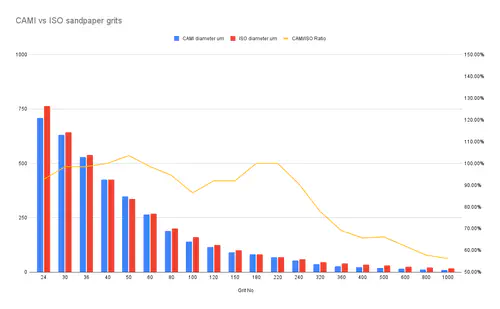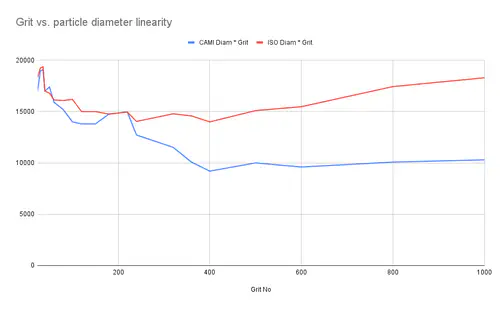There are two main classifications of sandpaper: the American CAMI/ANSI standard, and the international ISO/FEPA standard that is replacing it. The CAMI grit size is designated by a number (e.g. “220”), while the ISO grit size is designated by the letter “P” followed by a number, e.g. “P220”.
The tricky part is that the two grit numbers are not equivalent - for example, P360 is rougher than 360. Here is a chart showing the grit size and the ration of grit sizes for numbers from 24 to 1000:
The left axis indicates the grit diameter in um, and the right axis indicates the percentage ratio between CAMI and ISO grits. As you can see, the difference between the two scales is <25% up to 320 grit.
In other words, for woodworking, it does not matter which scale you use until you get to grits 360 and above. You can even mix and match sandpaper from the two scales without issue.
Here is the same data in tabular format:
| Grit No | CAMI diameter um | ISO diameter um | CAMI/ISO Ratio |
|---|---|---|---|
| 24 | 708 | 764 | 92.67% |
| 30 | 632 | 642 | 98.44% |
| 36 | 530 | 538 | 98.51% |
| 40 | 425 | 425 | 100.00% |
| 50 | 348 | 336 | 103.57% |
| 60 | 265 | 269 | 98.51% |
| 80 | 190 | 201 | 94.53% |
| 100 | 140 | 162 | 86.42% |
| 120 | 115 | 125 | 92.00% |
| 150 | 92 | 100 | 92.00% |
| 180 | 82 | 82 | 100.00% |
| 220 | 68 | 68 | 100.00% |
| 240 | 53 | 58.5 | 90.60% |
| 320 | 36 | 46.2 | 77.92% |
| 360 | 28 | 40.5 | 69.14% |
| 400 | 23 | 35 | 65.71% |
| 500 | 20 | 30.2 | 66.23% |
| 600 | 16 | 25.8 | 62.02% |
| 800 | 12.6 | 21.8 | 57.80% |
| 1000 | 10.3 | 18.3 | 56.28% |
Some extra data - I wanted to see whether the ISO scale or the CAMI scale are more linear when comparing grit number and particle diameter. This chart shows (Grit number * Particle diameter) for both scales:
As we can see, there is no clear conclusion - the ISO scale is more linear for grits below 400, while the CAMI scale is more linear for grits above 600. The two scales are about equally linear in the 400-600 range.

